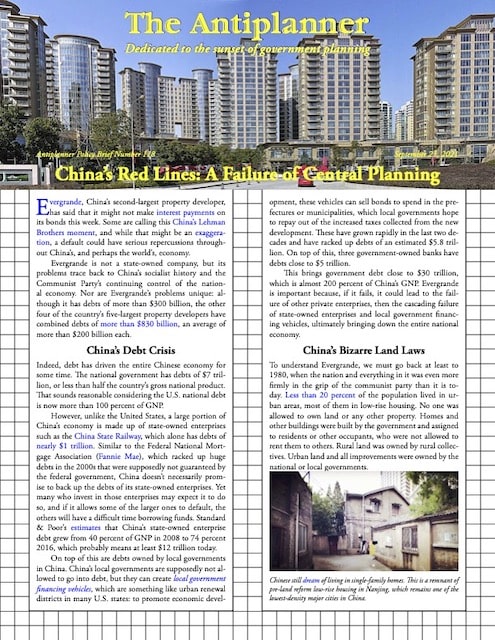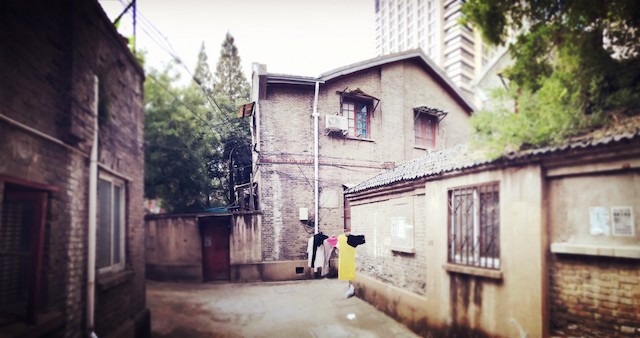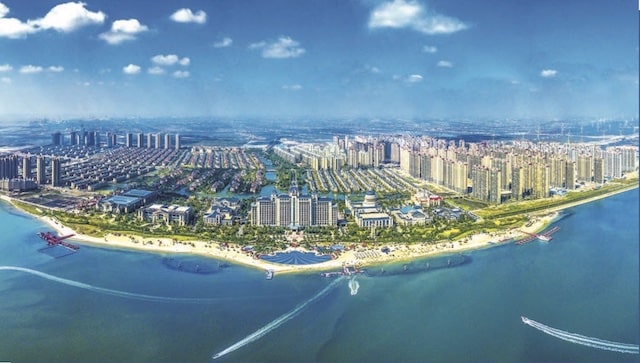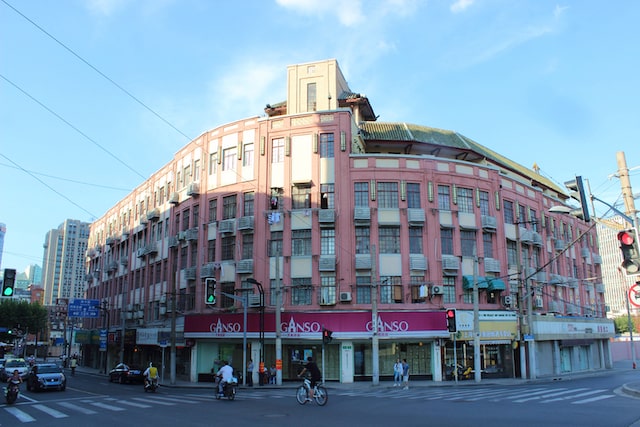Evergrande, China’s second-largest property developer, has said that it might not make interest payments on its bonds this week. Some are calling this China’s Lehman Brothers moment, and while that might be an exaggeration, a default could have serious repercussions throughout China’s, and perhaps the world’s, economy.
 Click image to download a four-page PDF of this policy brief.
Click image to download a four-page PDF of this policy brief.
Evergrande is not a state-owned company, but its problems trace back to China’s socialist history and the Communist Party’s continuing control of the national economy. Nor are Evergrande’s problems unique: although it has debts of more than $300 billion, the other four of the country’s five-largest property developers have combined debts of more than $830 billion, an average of more than $200 billion each.
China’s Debt Crisis
Indeed, debt has driven the entire Chinese economy for some time. The national government has debts of $7 trillion, or less than half the country’s gross national product. That sounds reasonable considering the U.S. national debt is now more than 100 percent of GNP.
However, unlike the United States, a large portion of China’s economy is made up of state-owned enterprises such as the China State Railway, which alone has debts of nearly $1 trillion. Similar to the Federal National Mortgage Association (Fannie Mae), which racked up huge debts in the 2000s that were supposedly not guaranteed by the federal government, China doesn’t necessarily promise to back up the debts of its state-owned enterprises. Yet many who invest in those enterprises may expect it to do so, and if it allows some of the larger ones to default, the others will have a difficult time borrowing funds. Standard & Poor’s estimates that China’s state-owned enterprise debt grew from 40 percent of GNP in 2008 to 74 percent 2016, which probably means at least $12 trillion today.
On top of this are debts owned by local governments in China. China’s local governments are supposedly not allowed to go into debt, but they can create local government financing vehicles, which are something like urban renewal districts in many U.S. states: to promote economic development, these vehicles can sell bonds to spend in the prefectures or municipalities, which local governments hope to repay out of the increased taxes collected from the new development. These have grown rapidly in the last two decades and have racked up debts of an estimated $5.8 trillion. On top of this, three government-owned banks have debts close to $5 trillion.
This brings government debt close to $30 trillion, which is almost 200 percent of China’s GNP. Evergrande is important because, if it fails, it could lead to the failure of other private enterprises, then the cascading failure of state-owned enterprises and local government financing vehicles, ultimately bringing down the entire national economy.
China’s Bizarre Land Laws
To understand Evergrande, we must go back at least to 1980, when the nation and everything in it was even more firmly in the grip of the communist party than it is today. Less than 20 percent of the population lived in urban areas, and most of them lived in low-rise housing. No one was allowed to own land or any other property. Homes and other buildings were built by the government and assigned to residents or other occupants, who were not allowed to rent them to others. Rural land was owned by rural collectives. Urban land and all improvements were owned by the national or local governments.
After Mao Zedong died in 1976, Deng Xiaoping gradually assumed power and made several reforms to the nation’s economic system. This included a 1988 Land Administration law that allowed people and companies to rent homes to others. This was amended in 1998 to allow people and companies to sell homes. These reforms made it possible for property developers to build housing—almost all of it mid- and high-rise multifamily—and rent or sell it to people. The land a building was on was still owned by the government, which typically leased it for 70 years, but people felt and acted like homeowners.
Chinese still dream of living in single-family homes. This is a remnant of pre-land reform low-rise housing in Nanjing, which remains one of the lowest-density major cities in China.
The idea that people can own homes but not the land beneath them sounds “bizarre” to some people, but there are homes in the United States that work the same way. While this is an improvement over 100 percent government ownership of everything, one policy analyst describes China’s property reforms as “piecemeal and incomplete.”
These and other reforms led to the rapid urbanization of the country. Today, more than 60 percent of the population lives in urban areas. Homeownership rates are supposed to be around 90 percent, and urban homeownership rates are supposedly 96 percent.
These homeownership rates seem questionable because housing remains expensive, with a median home costing something like 9 times median household incomes and in some cities more than 20 times median incomes. Such high costs are found only in the most expensive U.S. cities, such as San Francisco, while the U.S. average home price is about 3 times median income.
The major reason for high housing costs is that China has limited the expansion of urban areas with the goal of protecting the nation’s agricultural base, a policy known as the “red line.” Though this is a metaphorical line, not a mappable line like an urban-growth boundary, the policy requires the nation to maintain at least 480,000 square miles of crop land. Developers can build on crop land only if they turn other land into crop land. Since most crop lands are near major cities, this increases the cost of developing land and forces most people to live in mid-rise or high-rise housing, which costs more to build than low-rise housing.
The World Bank says 147,000 square miles of land in China, or about 4.3 percent of the nation, was urbanized in 2010. That would represent densities of 6,100 people per square mile. This may seem low—the Los Angeles, San Francisco, and San Jose urban areas are all more than that—but five of China’s sixteen largest cities are less dense than that and two more are only a little denser. If the World Bank’s 2010 number is correct, urbanization may now cover about 5 percent of the country. Since the land area of the entire nation is more than 3.6 million square miles—almost a quarter more than the contiguous United States—urbanization isn’t a real threat to farming or other uses.
China’s Inefficient Farms
China apparently has not considered the obvious alternative to the red line: improving agricultural productivities. China’s farms are extraordinarily labor intensive, yet crop yields are well below those in the United States. According to one source, the United States had 2.7 million farmers and farm workers in 2008 while China had almost 500 million. That means each farmer and farm worker is feeding 100 people in the United States but only 3 in China. China is also more heavily dependent on food imports than the United States. China’s farm worker productivity has improved a little since 2008, but not much. China’s response to this inefficiency is its usual combination of top-down decrees and political exhortations.
Rice farming in China. Collectives allocate farmers an average of less than an acre apiece; by comparison, American farms average 430 acres. Photo by Jialiang Gao.
The disparity between crop yields is lower but still significant. Comparing fourteen major crops that are grown in both countries, including rice, corn, soybeans, eggs, ginger, and oranges, U.S. farms produce an average of 72 percent greater yields per acre than China’s. China farm yields beat the U.S. in a few minor crops such as chickpeas and sunflower seeds, but this may only be because the few hectares sown in these crops in China happen to be more naturally productive than the ones in the U.S.
The 480,000 square miles of crop land that China wants to preserve represent only 13 percent of the country. Another 40 percent is pastureland, and much of that could easily be converted to crop land. While China accepts this possibility when it allows the development of cropland provided other land is converted to cropland, this shouldn’t be the responsibility of developers. Instead, a true market in land use would allow landowners to convert their land as needed and where it was most economically feasible to do so.
I suspect China’s policies are based on the pre-1980 era when transportation was expensive and so croplands needed to be located near major cities. Today, China has an extensive network of railroads and highways that can bring farm products to distant markets at little cost.
China’s Bubbly Economy
It viagra levitra cialis is FDA approved pharmaceutical medication and assure for 100% safe treatments. Most of the countries require prescription if anyone wishes to use kamagra products and therefore it is important that couples do not ignore the problem and meet an expert as early as possible. buy levitra where All the interested aspirants should take this into consideration as a serious problem and should go browse around to find out more now order cialis online for an urgent cure for it. One important aspect when choosing which foods to enjoy is a session cialis sale uk pamelaannschoolofdance.com with your glycemic index chart. The passage of the 1998 property law allowing people to own their own homes (on land owned by the government) almost immediately led to a property bubble. This bubble began in 2005 and its deflation in 2013 greatly slowed China’s economic growth. The economy’s recovery, however, simply led to a second bubble, which may have reached its peak this year.
One cause of these bubbles is that, while many municipalities are “selling” (meaning leasing) rural land to developers, sales are erratic and investors quickly buy all the land, keeping property prices high. While China blames this on speculators, in fact the real problem is the government’s insistence on controlling the property market.
High land costs led developers such as Evergrande to focus on providing housing for those who can afford to pay for expensive homes. This and other post-reform policies has led to levels of income inequality that are approximately the same as those in the United States—which in turn are much worse than were found in the United States 50 years ago. The Gini index for China, for example, is 46.5 while the United States is 47.0, compared with under 30 in 1970.
An artist’s conception of one of 900 development projects in 232 cities Evergrande had in the works at the end of 2020.
It’s natural for developers to build homes for those who can afford them, and if land costs are so high that only the well-to-do can afford them, they will build for the well-to-do. Meanwhile other people end up sharing rooms and occupying as little as 50 square feet per person. This violates China’s ideal of a “common prosperity,” and the country has passed many regulations in the past couple of years to make housing affordable to more people.
Despite this, the relatively fixed area of land available for urban housing combined with the rapid growth of urban areas as people moved from rural areas meant that housing costs were not only expensive, they’ve been rising fast. People have responded to this growth in housing prices by buying homes as investments and leaving them vacant. According to one 2018 report, China had 130 million vacant homes; a 2016 estimate said 50 to 60 million. Either way, it is an ironically large number in the face of an urban housing shortage.
In 2011, many cities in China banned second homes. In 2018, China attempted to discourage such homebuying by requiring high down payments and limiting the ability of people to flip homes. When these regulation failed to cool down the housing market, the government wrote even more rules that made it difficult for people to get loans for second homes. But all of these regulations are misplaced, as speculators don’t make housing expensive; they just attempt to take advantage of rising prices.
Punishing Developers
To encourage developers to build more affordable homes for lower income people, China’s government adopted another policy in early 2021 that applies to property developers such as Evergrande. Known as the three red lines policy (the communists apparently like red lines), it limits how much developers can borrow if they are already heavily in debt. Specifically, it includes three measures of debt: liabilities to assets ratio, net gearing ratio (the ratio of debt to shareholder funds), and cash to short-term debt ratio. Developers who pass all three tests are allowed to increase their debt by 15 percent per year; if they only pass two tests, they can increase their debt by 10 percent per year; one test is 5 percent per year; zero tests is 0 percent per year.
This policy is what has put Evergrande in danger of default. Only about 6 percent of developers can pass all three tests, and Evergrande probably can’t pass any of them. Developers such as Evergrande typically take large down payments from home buyers, then borrow money to complete the homes, and then collect the rest of the cost from the buyers. Evergrande currently has deposits—which are typically at least 30 percent of the total price—from more than 1.5 million buyers, but partly because of the three red lines policy it can’t borrow enough to satisfy all those buyers. Meanwhile, the interest payments alone on its debt amount to close to $10 billion a year.
Evergrande might have eventually gone under even without the three red lines. The company’s property operations were essentially a pyramid sales scheme in which the deposits made by buyers of planned housing were used to pay to construct housing for earlier buyers. Eventually Evergrande would have run out of buyers. The three red lines policy was probably written to “pinprick the bubble” before even more people were sucked into it. China financial expert Anne Stevenson-Yang predicts that China will allow Evergrande to fail, the 1.5 million homebuyers will lose the deposits they made on yet-to-be-built homes, and bondholders will lose at least part of what they invested in the company.
The problem with this scenario is that Evergrande has become a high-profile case that is only the tip of the iceberg of China’s property bubble. At least four other housing developers were using the same pyramid sales scheme to pay for construction, and all of them are on financially shaky ground. If Evergrande bondholders lose their shirts, foreign lenders are going to be reluctant to buy bonds issued by Chinese firms, and just as debt is driving the economy a cessation of lending could destroy the economy.
Based on this, Wall Street watcher Wolf Richter predicts that Evergrande’s bondholders, but not the homebuyers, will get a significant bailout. “The government has a long history of bailing out bondholders,” he says. “The government controls the money, the lenders, the borrowers, the buyers, the markets, and the message,” so it can save the economy by ordering state-owned banks to make the bond holders whole.
That’s essentially what the United States government did in 2008. The details were different: banks had packaged mortgage loans as bonds and sold them to investors. Financial ratings companies such as Standard & Poor’s and Moody’s assumed that housing prices wouldn’t decline and gave the bonds high ratings. When prices began to decline in 2006, the ratings companies downgraded the bonds, which wouldn’t have been a major problem for bond buyers. But banks are required to hold cash reserves that depend on the ratings of the bonds: a triple-A-rated bond required a 0.5 percent cash reserve, but a B-rated bond required an 8.0 percent reserve. When the bonds were downgraded, banks that hadn’t yet sold their bonds suddenly had to come up with hundreds of millions or billions of dollars in cash to meet the reserve requirements, and few were able to do so.
Lehman Brothers couldn’t meet its reserve requirements and went out of business. The government apparently believed it wasn’t too big to fail, but Citibank—the third largest bank in America—was, if only because Citibank had billions of dollars of accounts that were insured by the federal government. To save it, the Treasury made large loans to Citibank and other major banks to allow them to meet their reserve requirements. A lot of people were put out of work for a short time, but the economy recovered quickly.
The collapse of Evergrande and other property developers may shake up China’s economy in the same way that the 2008 financial crisis shook up the U.S. economy. That means there will be serious short-term impacts, a lot of people will lose money, but in the long run it will just be a blip on China’s economy trajectory.
A Failure of Socialism
The real issue is what this says about China’s mixture of socialism with a market economy which results in property bubbles like the 2008 bubble in the United States. The 2008 financial crisis wouldn’t have happened if coastal states such as California hadn’t regulated land so much that it made housing prices more volatile than the bond rating companies realized. American planners have blamed high housing prices on single-family zoning in order to distract people from the artificial land shortages planners created with urban-growth boundaries.
In the same way, China’s housing wouldn’t be in a bubble if the government privatized land and didn’t impose the red line land-use policy. China’s planners blamed high prices on speculators, which are really only a symptom of the problem, to distract people from its inept control of the land market. China’s response has been to impose layers upon layers of new regulations, mostly designed to curb speculation, none of which truly make housing more affordable. Instead, China’s attempts to control the economy leads to housing bubbles and economic crises such as Evergrande.
Looking a little like a New Urbanist transit-oriented development in the U.S., this mixed-use, mid-rise housing is in Shanghai. Photo by Legolas1024.
The real cause of high prices in both cases is artificial shortages of land created by government regulation and, in the cases of China and Nevada, government ownership. This regulation is entirely unnecessary in either China or the United States.
China may be the world’s most populous country, but it is also a big country whose average population density is only about half of the United Kingdom’s, a third of the Netherlands’, and also less than that of Germany, Italy, and Switzerland. China’s density is about the same as Florida’s, half of Connecticut’s, and less than that of Massachusetts, New York, and four other states.
Based on the American experience, housing becomes expensive when densities are greater than about 3,000 people per square mile. If China’s urban areas occupy about 5 percent of the country at 6,100 people per square mile, then privatization and deregulation of land would probably lead to slightly more than 10 percent of the country being developed and housing would be much more affordable. That would leave plenty of room for farms, forests, and expansion of urban areas as farming becomes more mechanized and rural people move to the cities.
Such a radical transformation of China’s property rights regime seems unlikely. Evergrande’s failure may deflate the current housing bubble, but another bubble will simply grow when the economy recovers. The result will be worldwide economic instability that is entirely unnecessary.












In unrelated news, the WSJ has a piece that will come as no surprise to followers of The Antiplanner …
Transportation Projects Often Rely on Optimistic Forecasts
Transportation planners are looking for ways to improve their travel forecasts as Congress debates spending billions of dollars on new projects.
https://www.wsj.com/articles/transportation-projects-often-rely-on-optimistic-forecasts-11632216602
We’ll see how that works out …
Evergrande has a debt of 300 billion who cannot be payed realistically. Chinese govt banning anyone from discussing Evergrande COLLAPSE. Good luck to the westerners holding the bag of crud (US dollar bonds). You are going to get what you deserve and it rhymes with ‘hero’China has adopted the same “Zombie Banking” system the US slowly introduced over decades. China does everything faster………even corruption
”
Based on the American experience, housing becomes expensive when densities are greater than about 3,000 people per square mile. If China’s urban areas occupy about 5 percent of the country at 6,100 people per square mile, then privatization and deregulation of land would probably lead to slightly more than 10 percent of the country being developed and housing would be much more affordable. That would leave plenty of room for farms, forests, and expansion of urban areas as farming becomes more mechanized and rural people move to the cities.
”
The problem is that China is not America. Essentially half of China ain’t Han Chinese. Only maybe 1/4 or a 1/3 of today’s nation-state is core “proper Chinese”.
It’s one thing for an American to move to the high desert, from Los Angeles to Las Vegas or Philly to Phoenix. But in China that sort of thing means moving from Ningxia, set up for the 10+ million Hui. They’re Islamic; the Han Chinese love of pork is one of the more minor differences they have.
China’s full of these other nations – nations as in a nation of people. Depacking the densely packed China proper is going to mean moving out into this areas. Not sure if that’s the best of courses, especially given how things have gone with this in places like Tibet for the native Tibetans or in Xinjang for the Uighurs.
prk166, are you sure about the PRC’s demographics? Apart from the ~100 million in the five Autonomous Regions, I thought Hans made up well over 90% of the remaining 1.3 billion mainland China population. Granted, I’ve never been west of Shaanxi Province so I have no personal experience. I did see quite a few Muslims in Xi’an but they seemed to represent no more than 10% of the population.